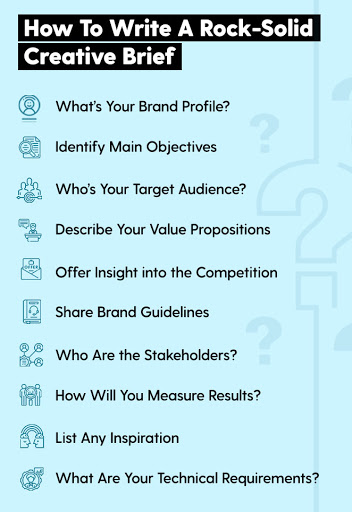Writing a creative brief might sound simple.
However, it can be hard to convey relevant information in a concise format and not miss out on anything important. A good creative brief transparently communicates a brand's vision. It ensures everyone’s on the same page, even if the project calls for external or remote collaborators.
What Is A Creative Brief?
A document created by a project manager that works as the foundation or the starting point. It captures key details including objectives, challenges, and messaging. Brands and agencies use it to create a game plan to build a campaign or project that fulfills the intended goal.
Benefits Of A Creative Brief:
- Achieve designs that match a brand's visualization
- Help to manage expectations of a project
- Build a project timeline with a clear purpose
- Reduce multiple rounds of revisions
How To Write A Rock-Solid Creative Brief
1. What’s your Brand Profile?
Every interaction begins with an introduction. It is the same for a creative brief.
A compelling brand profile sets the tone for the rest of the creative brief and helps the team get a snapshot view of the brand. The profile includes details on how the brand was established, it's values, mission, products, and services.
.jpg)
2. What are the Main Objectives?
This is where you explain the core ‘what’ of the creative project. Outlining objectives or possible challenges offers the team a clear direction. They will strive to build a design that fulfills the specified purpose.
For example, perhaps a brand wants to enter a rural market and is struggling to get the message across.
With this objective in mind, the consequent packaging graphics will reflect colors that appeal to the rural target audience. To attract attention, the packaging will also be adapted to include information in regional languages.
Ironically, while it is 'creative brief', the technical things like target audience, product positioning, and sales strategy helps form the actual creative.
- Tejas Patel, Business Development Consultant, Bizongo
3. Who’s the Target Audience?
In this section, nail down the brand’s specific customer base and sketch out their buying behavior.
With basic demographics such as age, gender, and geography, this section will also include factors like a customer’s pain points, interests, aspirations, lifestyles, and habits. This will help the team to build customer-centric designs.
4. What Are The Value Propositions?
Simply put, what makes a brand unique?
Value propositions are based on how the product helps solve problems, satisfy customer needs, and stand out in the market. The final product design will reflect these values.
5. Who’s The Competition?
Along with an understanding of the target audience and value proposition, competitor analysis will be essential in building a successful product positioning.
A complete SWOT analysis - strengths, weaknesses, opportunities, threats - help decode a brand. It helps the design team get a bird’s eye view of the market and achieve strong results in the least amount of time.
- Sakhi Bansal, Design Lead, Bizongo
SWOT analysis can include questions such as:
Who are your competitors?
How do the competitors relate to customers?
Why are customers buying from them?
Where are they advertising their products/services?
Answering these questions and others can help teams to recognize any market gaps and build a unique brand positioning.
6. Are There Any Brand Guidelines?
If the client has an existing brand guideline, it will help the creative team to understand aspects such as logo, color palette, typography, tone, voice, and imagery. They will be able to adapt designs for seamless visual harmony.
.jpg)
7. Who Are The Stakeholders?
Managing a creative project is a collaborative process. Design projects often involve multiple teams, where overall productivity becomes key.
Gain visibility on the number of stakeholders that will be involved in every stage of the approval process. Where are they based? Do they work remotely? Perhaps, the file needs to be sent to a printer in a different time zone. All this information will help the team frame realistic timelines and accordingly complete projects.
8. How Will You Measure Results?
While objectives help drive a creative project, results will determine if those objectives have been fulfilled. The results can be either quantitative or qualitative depending on the goals.
The client might be looking to garner x percentage of the market share with new product lines or building brand recall through refreshed branding.

9. Any Design Inspirations?
A great design means you have achieved what the client was visualizing. While a creative brief offers detailed insight, inspirations or examples help the team to understand what the client is really visualizing.
10. Do You Have Any Technical Requirements?
It’s best to share technical requirements upfront, such as formats, sizes, or any particular dimensions. Also, give space to add a tentative timeline in the brief itself to help prioritize tasks and move at an appropriate pace.
To sum up;

Some Closing Tips For A Creative Brief That Works For You:
Skip the jargon and buzzwords. Use simple language, be direct & concise.
Share the brief format with different teams & get clear feedback
Be ready to answer any follow-up questions
Now that you know the basic elements of a creative brief, it's time to actually craft one. Remember, that the effort in building a creative brief might seem like an uphill task, but in the long-term, it will help align teams - internal, external, or remote.

.svg)
.svg)












.webp)



